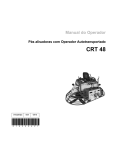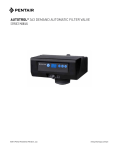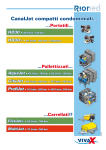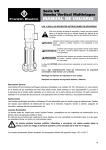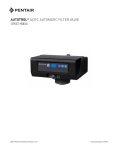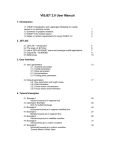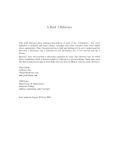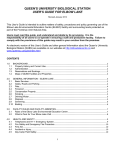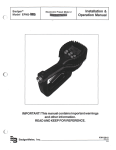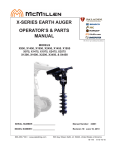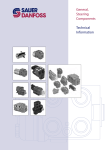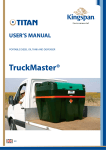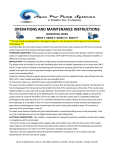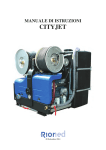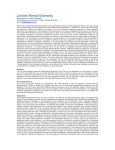Download here - Andy Guest Jetters
Transcript
WWW.ANDYGUESTJETTERS.CO.UK by ANDY GUEST JETTERS OPERATOR’S MANUAL V-PACK + COMPACK SERIES OF HIGH PRESSURE JETTING EQUIPMENT © Copyright April 2015, Andy Guest Jetters Ltd Unit 11, Riparian Way The Crossings Business Park Cross Hills Keighley West Yorkshire, UK BD20 7BW Tel: +44 (0)3300 240404 Fax: +44 (0)1535 636969 Email: [email protected] Web: www.andyguestjetters.co.uk All rights reserved. No part of this publication may be copied or published by means of printing, photocopying, microfilm or otherwise without the prior written consent of Andy Guest Jetters Ltd. This restriction also serves in respect of all corresponding drawings and diagrams. Andy Guest Jetters Ltd has the right to change components and assemblies at any time without prior or direct correspondence with the operators. The contents of this manual may be changed without any prior warning. This manual is to be used only for the equipment models stated. For additional technical information or support please contact your local service agent which may be located on the Company’s website. TABLE OF CONTENTS 1.0INTRODUCTION 4 2.0 2.1 2.2 2.3 2.4 2.5 2.6 5 5 6 6 6 7 7 FUNCTIONALITY & GENERAL SAFETY Equipment methodology Safety Icons Critical Safety Features Personnel Protection Equipment (PPE) General Warnings Making Changes and Fabricating Non OEM Components 3.0 TECHNICAL SPECIFICATIONS 8 2.2 V-PACK Series 2.3 COMPACK Series 8 9 4.0CONSTRUCTION 10 4.1V-PACK 4.2COMPACK 10 11 5.0CONTROLS 12 5.1 5.2 5.3 5.4 5.5 5.6 5.7 5.8 5.9 5.10 5.11 5.12 5.13 5.14 12 12 12 13 13 13 13 13 14 14 14 14 15 15 Before Departure Positioning the Vehicle Hydraulic Reel Control Engine Counter Run Dry Protection (Optional) Pre-Operational Checks Starting the Engine Using the Hard Wire Remote Control (Optional) Using the Radio Remote Control (Optional) Nozzle Application Using Lances Completion Procedures Frost Protection Recommended Maintenance Schedules 6.0TROUBLESHOOTING 16 6.1 Declarations & Directives 6.2 Useful Links & External References 16 17 7.0APPENDIX 18 7.1 7.2 18 20 Declarations & Directives Service Centres 1.0INTRODUCTION Foreword This operator’s manual is designed for trained and competent users of industrial jetting equipment as prescribed by the Water Jetting Association of the United Kingdom. The purpose of the manual is to ensure safe and efficient operation of the equipment with any associated drawings or images to serve as a guide only. In each section we try to familiarise users with the most important safety aspects to consider prior to the operation of the equipment along with the operating controls and diagnosis of potential faults. Andy Guest Jetters Ltd wishes to first thank you for your purchase of our drain and sewer-clearing equipment. We recommend that you read this manual thoroughly to ensure that the equipment is maintained and operated to the highest standard. If you require technical support, additional parts or services or indeed would like to schedule an approved service – please don’t hesitate in contacting us. Other common uses for the equipment include the cleaning and maintenance of walls, floors, building materials and rubbish containers with cold or warm water and can be used with our collection of lances and accessories. If you aren’t sure about a particular application you should always contact us in the first instance for advice as no liability can be placed on the company for consequential damage, theft or injury to persons or property. The machine is built by: This manual contains all the necessary information concerning control and maintenance. If the device is installed correctly, properly controlled and regularly maintained then the owner may invoke a warranty claim for non-wear parts subject to the terms of sale (which is normally 12 months from date of invoice for new equipment and 3 months on second hand purchases). Should, following our investigation it be determined that the control and maintenance procedures are not diligently followed, the warranty will become invalid – this does not affect your statutory rights. Andy Guest Jetters Ltd Unit 11, Riparian Way The Crossings Business Park Cross Hills Keighley West Yorkshire, UK BD20 7BW The equipment has been specifically designed and manufactured for cleaning and unblocking domestic and commercial drains in conjunction with the uniquely calibrated high pressure jetting nozzles that are supplied with your equipment (other specialist nozzles are available for pipe cleaning, silt removal, high fat content, other foreign material based blockages and root cutting). 4 V-PACK + COMPACK Operator’s Manual The machine may only be used by authorized personnel and should not be operated in an explosive or hazardous environment. In this manual you will find all necessary information concerning the operation and maintenance of your machine. 2.0 FUNCTIONALITY & GENERAL SAFETY 2.1 Equipment Methodology ⊲⊲ 1 bar is equal to 14.5 psi The integrated engine drives the high-pressure pump using a V-belt. This pump receives water from the water tank (which is usually filled via the inlet reel), via the water filter before pressurisation is applied to the desired level. The pressurised water is ejected through the high-pressure hose (black in colour and mounted on the HP reel) and eventually passes through the high pressure jetting nozzle. ⊲⊲ 1 UK gallon is equal to 4.55 litres Many operators also purchase and install a three metre “leader hose” which is normally blue in colour. When retracting a hose that is in operation, this tells the operator that they are nearing the end of the line and so the pump should be turned off to reduce the risk of high pressure water being on operation outside of the confines of the application, for example the sewer pipe. High pressure water and an “out of control” nozzle present one of the highest risks to health and property when this equipment is in use. Most machines are derived by the type and power of the engine – normally between 20-55 horsepower (HP). Typically the size of engine will determine the size of pump however these can be varied in accordance with the two principal factors of jetter specification – pressure (velocity of water) and flow (volume of water). These are normally quoted in PSI (pounds per square inch) or BAR (derived from the Greek word baros meaning weight with 1 bar being equal to atmospheric pressure) and Gallons or Litres per minute – for example 3000@12 refers to 3000psi at 12 gpm and is considered one of the most common specifications to deal with the largest volume of drain blockages in the most efficient manner. There are many types of engines and pumps and many arrangements of equipment resulting in different weights, sizes, serviceability and performance. Our equipment has been developed over time to provide a configuration that we believe offers a high level of performance, safety and reliability with low ownership costs. Whilst the financial measure of the life of our equipment tends to be governed by customer accounting policies, the practical life of the machine if properly maintained can be up to 20 years depending on usage. Typically we would recommend replacement after 7-10 years when performance begins to deteriorate and cost of refurbishment is no longer viable to achieve original performance parameters. There is a market for used machines for which our brand of equipment is still very desirable and as such we would always recommend having second hand equipment that hasn’t been refurbished by the OEM (original equipment manufacturer) or a recognised service agent – to be multi-point checked prior to operation. Other common accessories for safety and efficiency include hard wired remote controls to turn the water on and off when up to 100m away from the operating vehicle, or radio/wireless remote controls which can have the facility to start/stop water, start/stop engine, retract the high pressure hose reel or provide emergency stop capabilities, depending on the number of channels purchased and installed. V-PACK + COMPACK Operator’s Manual 5 2.0 FUNCTIONALITY & GENERAL SAFETY There are numerous accessories to provide additional protection for people or equipment such as safety lances that prevent a build-up of back pressure to the machine, unloader valves which return back pressurised water back to the tank unlike the standard burst disc arrangement, run dry switches that prevent pump operation if the operator runs out of water, hose guidance adapter so that operators don’t have to come into contact with the high pressure hose when retracting from a sewer line and many other additional yet optional features. As well as the general information in this chapter, you should also follow the safety guidance in the other chapters. Always consider the safety of yourself and others when operating this machine – try to complete risk assessments before each job to highlight potential hazards and either avoid and/or protect people and equipment from their consequences. 2.2 Safety Icons Any safety warnings in this manual that are accompanied by the safety icon below (Security sign DIN 4844-W9) are considered to present a high level of danger to persons or equipment and should be followed at all times. DIN 4844-W9 This machine is equipped with an emergency stop. By operating the emergency stop, the machine will stop immediately. Do not use this button for normal operation and only use it in emergencies. The stop button will remain depressed after application so that the equipment cannot be restarted. If used, and only when the danger has been averted, twist/pull the emergency stop button back out in order to be able to use the equipment again. Ensure the emergency stop is always accessible. Security Covers This machine is equipped with several safety covers designed to protect users from rotating parts or hot surfaces. Do not remove these security covers. 2.4 Personnel protection equipment (PPE) The following PPE is prescribed when operating the equipment: ⊲⊲ Ear protection (LWA 109dB) ⊲⊲ Eye protection ⊲⊲ Hand Protection (gloves) ⊲⊲ Waterproof clothing ⊲⊲ Spray boots with toe protection 2.3 Critical Safety Features 6 Emergency Stop V-PACK + COMPACK Operator’s Manual Always apply PPE prior to operation of the equipment and use your risk assessments to determine if additional PPE is required. 2.5 General Warnings From our experience of commonly reported incidents and near misses, please take note of the following: ⊲⊲ Never operate the equipment near a person or animal ⊲⊲ Use protective barriers to reduce the risk of unauthorised access to the work area ⊲⊲ Never block the control levers in any way or lean equipment on or near them ⊲⊲ Ensure that the high pressure nozzle does not leave the drain whilst the unit is in operation ⊲⊲ Before using a spray gun, you must always set the pressure below the maximum (± the half of the maximum pressure is recommended) and this should be done before the machine is started If the safety guidance is not observed you increase the risk of near-misses and serious accidents. Always try to recognise the important functions and controls, ensure you follow maintenance and pre-check recommendations and most importantly remember that no job is worth risking the safety of yourself and others. 2.6 Making Changes and Fabricating Non OEM Components Changes to the machine will affect your warranty and may result in significant rectification costs or potential safety hazards and therefore should only be conducted if authorised in writing and in advance by an authorised representative of Andy Guest Jetters Ltd. ⊲⊲ Never exceed the maximum pressure that is marked on the manometer when using the spray gun ⊲⊲ After use of the high-pressure circuit ensure that you depressurise it ⊲⊲ Always check for electrical feeds or equipment if you are cleaning with a spray gun ⊲⊲ Always check for loose items near the application of the spray gun to avoid them becoming projectiles ⊲⊲ Personnel that use, maintain and inspect the equipment should be suitably qualified and authorised. V-PACK + COMPACK Operator’s Manual 7 3.0 TECHNICAL SPECIFICATIONS V-PACK SERIES Machine Model/Type 2 Series Stack 2 Series 3 Series 4 Series Std Water Tank Capacity 210 Litres 210 Litres 400 Litres 400 Litres Frame Construction Compact mild steel construction, shot blasted, zinc primed & powder coated Engine Kohler V Twin Diesel 3 Cylinder Diesel Lombardini LDW1404 Lombardini LDW2204 Engine Power 20HP (14kW) 33HP (24kW) 44HP (32kW) 20HP (14kW) Hours Run Time Monitor Engine Based HP Pump Type Interpump Interpump Speck NP Speck P Capacity 3000PSI / 8GPM 3000PSI / 9GPM 3000PSI / 12GPM 3625PSI / 13GPM (Others Available) 200Bar / 38LPM 200Bar / 40LPM 200Bar / 54LPM 250Bar / 60LPM Engine Cooling Air Cooled Water Cooled Water Cooled Water Cooled Run Dry Protection Optional Frost Protection Anti Freeze Valve Hydraulic Drive HP Hydraulic Hose Guidance Optional High Pressure Hose Length 45 Metres ½” Std 90 Metres ½” Std 90 Metres ½” Std Fixed Reel Hose Reel Arrangement Filling Hose 90 Metres ½” Std Optional Optional 25 Metres 25 Metres Yes Control Box 5 Channel (Optional) Remote Control 2 Standard Nozzles ~ User Manual ~ back pressure safety burst disc Included Accessories Approx Dry Weight* 360 KG 360 KG 455 KG 565 KG Approx Max Weight* 570 KG 570 KG 855 KG 965 KG 1250 x 1200 x 1200 1350 x 1300 x 1350 1350 x 1350 x 1350 *with standard tank *with standard tank *with standard tank 20 Litres 20 Litres 30 Litres Machine Dimensions (Mm) (Length, Width, Height)* Fuel Tank Capacity TBC 20 Litres Upgradeable 8 V-PACK + COMPACK Operator’s Manual YES COMPACK SERIES Machine Model/Type 3 Series 4 Series 5 Series Std Water Tank Capacity 400 Litres 400 Litres 400 Litres Frame Construction Compact Lightweight aluminium construction, self colour option Engine Lombardini LDW1404 Lombardini LDW2204 Lombardini LC Engine Power 33HP (24kW) 44HP (32kW) 50HP (37kW) Hours Run Time Monitor Engine Based HP Pump Type Speck NP Speck P Speck P Capacity 3000PSI / 12GPM 3625PSI / 13GPM 4000PSI / 13GPM (Others Available) 200Bar / 54LPM 250Bar / 60LPM 275 Bar / 60LPM Engine Cooling Water Cooled Water Cooled Water Cooled Run Dry Protection Optional Frost Protection Anti Freeze Valve Hydraulic Drive HP Hydraulic Hose Guidance High Pressure Hose Length Yes 80 Metres ½” NW13 (LightWeight) 80 Metres ½” NW13 (LightWeight) Hose Reel Arrangement Fixed Reel Filling Hose 25 Metres Control Box Yes Remote Control 100 Metres ¾” NW19 (LightWeight) 5 Channel (Optional) Included Accessories 2 Standard Nozzles ~ User Manual ~ back pressure safety burst disc Approx Dry Weight* 420 KG 530 KG 535 KG Approx Max Weight* 820 KG 930 KG 935 KG Machine Dimensions 1100 x 1200 x 950 1350 x 1350 x 1050 1350 x 1350 x 1050 (Mm) (Length, Width, Height)* *with standard tank *with standard tank *with standard tank Fuel Tank Capacity 20 Litres 30 Litres 30 Litres Upgradeable YES V-PACK + COMPACK Operator’s Manual 9 4.0CONSTRUCTION 4.1V-PACK 05 04 03 01 09 07 15 06 08 18 14 02 19 17 11 10 20 21 13 12 01 High Pressure Hose & Reel 12 Anti-freeze suction pipe 02 Overflow pipe 13 Selector Valve 03 Water tank 14 Pump 04 Supply opening water tank 15 Hose guidance adapter 05 Inlet hose on reel 16 Drain 06 Hydraulic reel control 17 Hydraulic Oil tank 07 Throttle 18 Fuel tank with opening 08 Control box 19 Anti-freeze valve 09 Rotary joint 20 Hardwire remote socket 10 Pressure gauge 21 Emergency Stop 11 Water filter 10 V-PACK + COMPACK Operator’s Manual 16 4.2COMPACK 08 11 10 12 19 04 15 09 13 01 02 03 06 14 07 1 Low water override switch 9 Acoustic cover lock - female 2 Radio remote control switch 10 Acoustic cover support 3 Emergency stop (Also on V-Pack frame) 11 Inlet reel rotary joint 4 Leader hose 12 Selector valve 5 Drain & Anti-freeze valve 13 Fuel level sight gauge 6 Hydraulic reel control 14 Throttle 7 Water filter 15 Water Tank Flow Valve 8 Acoustic cover lock - male V-PACK + COMPACK Operator’s Manual 05 11 5.0CONTROLS Note: all controls and their operation will be clearly labelled on all new equipment. 5.1 Before Departure Before you drive away, check the following: ⊲⊲ Roll the HP-hose neatly and fully onto the hose reel ensuring no kinks ⊲⊲ Ensure the Hydraulic Reel Control is NOT in the “Free Wheel” position ⊲⊲ Roll the inlet hose neatly and fully onto the hose reel ensuring no kinks ⊲⊲ Ensure the water tank has been drained to approximately 10% capacity before driving 5.2 Positioning The Vehicle When positioning the vehicle please take note of the following: ⊲⊲ Vehicle engine turned off, vehicle in gear and hand brake applied ⊲⊲ Always try to site the vehicle on a level, hard standing ⊲⊲ See to it that the vehicle is more or less level. ⊲⊲ If parked on a hill your fuel may run out faster than usual if the liquid gathers away from the suction end ⊲⊲ Secure the working area according the local regulations ⊲⊲ Activate all appropriate hazard and work lights and beacons 5.3 Hydraulic Reel Control There are three settings for this control: ⊲ IN ⊲ OUT ⊲ FREE WHEEL In “FREE WHEEL” mode the reel can be manually operated either in or out. When the lever is 12 V-PACK + COMPACK Operator’s Manual positioned “OUT” the hydraulic motor will feed out the high pressure hose. When the lever is positioned “IN” the hydraulic motor will pull the high pressure hose back on to the reel. You can control the speed at which the hydraulic motor operates by adjusting the throttle lever. When operating the hydraulic reel control please take note of the following: ⊲⊲ The hose should remain pressurised when retracting until only 3 metres of hose remain in the drain or immediately upon sight of sight of the leader hose (optional) – this reduces the risk of the hose stretching or becoming compacted on the hose reel which upon re-pressurisation can cause damage to the hose and reel – always remove the jetting nozzle from the HP hose after use ⊲⊲ Do not let the unit run out of water prior to retraction, if this happens and you cannot find a local source of water, you should retract the hose manually and then when possible let out all hose, safely pressurise before hydraulic retraction is performed ⊲⊲ Always retract the hose slowly to ensure it is neatly rolled onto the reel, keep hands and clothing away from the reel to avoid crushing and always check for contaminants or sharps that may have lodged onto the reel (an optional hose reel guide is available to eliminate direct hand contact with the hose) ⊲⊲ It is good practice to check the condition of the hose during retraction and if you suspect any damage to the hose you should have it replaced by an authorised agent immediately 5.4 Engine Counter 5.7 Starting The Engine All engines are equipped with a visual hours counter. This indicates the total number of hours that the engine has been operated and can be used to determine when the unit is ready for maintenance and servicing. To start the engine please ensure the following: 5.5 Run Dry Protection (Optional) ⊲⊲ If you have a radio remote, ensure the switch is set to manual Some units are equipped with a run dry switch so that when the tank water level reaches approximately 5-10% the engine will automatically turn off, furthermore an override switch can also be added so that in the event that the run dry switch activates, the operator may still briefly use the engine to activate other functions such as the hydraulic reel control or the anti-freeze suction valve. 5.6 Pre-Operational Checks You should check the following prior to operation: ⊲⊲ Engine Oil ⊲⊲ Hydraulic Oil ⊲⊲ Pump Oil ⊲⊲ Fuel Level ⊲⊲ Water Level in main tank (maximum recommended water temperature is 60oc / 140of ⊲⊲ Water filter should be clean and free of debris ⊲⊲ Check nozzle holes and clear debris before attaching nozzle to the high pressure hose ⊲⊲ Connect the inlet hose to your supply feed and turn on OR put a supply hose directly into the water tank by removing the filler cap ⊲⊲ Ensure you are in a position to operate the equipment safely ⊲⊲ Ensure the emergency stop button is in the open position ⊲⊲ Insert the key and turn it to ignition holding until the glow plug light switches off and then start the engine ⊲⊲ If everything is running correctly, you will see a green light appear on the control panel ⊲⊲ If you receive any warning lights, please consult your engine booklet supplied with the new equipment or contact one of the service centres 5.8 Using the Hard Wire Remote Control (Optional) If you have purchased a hard wire remote control, you will receive a foot pedal and the requested amount of cabling (normally 80-100m). Plug your foot pedal connector into the hardwire remote socket prior to starting the engine – determine the pressure you require using the throttle and then apply the foot switch in order to turn water on via the pump. As soon as you release pressure from the foot switch, the water will stop. ⊲⊲ DO NOT switch of the engine with the foot pedal still depressed as this will result in pressurised water the next time the machine is turned on without the foot pedal connected. If you have done this inadvertently, remove the nozzle from the high pressure hose, position the hose to the ground or into a drain, plug in your foot pedal and start the engine – this will return the water to the off position V-PACK + COMPACK Operator’s Manual 13 5.0CONTROLS 5.9 Using The Radio Remote Control (Optional) 5.11 Using Lances If you have purchased a radio remote control, you should have had the receiver kit installed to your nominated vehicle by a qualified professional and have also received a remote handset. These will typically provide the following operations:- ⊲⊲ Dry Shut ⊲⊲ Remote On/Off ⊲⊲ Throttle Up/Down ⊲⊲ Water On/Off ⊲⊲ Emergency Stop Before starting the engine, switch the radio remote switch to “Radio Remote”, turn the ignition on and hold the corresponding “on” buttons down at the same time to turn on the remote – now start the engine. 5.10 Nozzle Application The high pressure nozzles are designed to use the hydraulic pressure to pull the hose through the sewer pipe and depending on application and nozzle, a degree of cleaning or unblocking will commence immediately. All nozzles will have the capability to eject water in a backwards direction to project them forward and others will also include forward ejecting water to assist in the clearance of blockages and debris. The basic principal can be seen below: There are two types of lance: ⊲⊲ Safety or Unloader If you are using a dry shut lance, you should ensure that you have an unloader valve fitted to your jetting equipment in lieu of a burst disc arrangement. The most common cause of burst disc failure (a manufactured weak spot to protect from backpressure) is when using lances. An unloader valve (or pressure relief valve) is designed to return water back to the water tank in the event that the back pressure exceeds the desired level. A safety lance or unloader lance has the valve incorporated in its design so that any back pressure will eject from the lance, normally through a secondary barrel pointing in the same direction as the pressurised water. You should always check that the working pressure on the lance corresponds with the pressure of the machine and start the unit on the lowest pressure setting and when in operation, increase slowly to the correct working pressure. After use and when the engine is turned off, activate the trigger to release pressure from the hose. 5.12 Completion Procedures At the end of the job, you should: ⊲⊲ Retract the HP hose and secure ⊲⊲ Remove nozzle from hose and store on frame bracket if applicable ⊲⊲ Retract the Inlet hose and secure ⊲⊲ Stop the engine, store any accessories and drain the water tank down to approximately 5-10% capacity 14 V-PACK + COMPACK Operator’s Manual 5.13 Frost Protection It is important to protect your equipment, particularly the high pressure pump from freezing as this can damage your equipment. You should never attempt to run your equipment if you suspect it has frozen. Many customers will install a night heater (optional) for cold weather periods though all equipment is fitted with an anti-freeze valve as standard. We recommend during cold weather that you either perform the anti-freeze procedure at the end of the day when the unit is no longer going to be used or prior to any long journeys. The following procedure should be applied: ⊲⊲ Drain water tank ⊲⊲ Turn anti-freeze valve to the open position (pointing towards the anti-freeze pipe) ⊲⊲ Put pressure hose into anti-freeze drum (ensure no nozzles are attached) ⊲⊲ Start engine and run until water starts running clear or drum has been filled to original level Obviously the process will have a slight diluting effect so care must be taken and it is only designed to reduce the risk of freezing so normal safety checks should always be conducted. 5.14Recommended Maintenance Schedules We would recommend the following maintenance plans conducted by a recognised service agent using only OEM parts. ACTION FREQUENCY Check oil levels Daily Clean water filter Daily or after high concentration of pollutants Service engine ⊲⊲ Start engine and run until anti-freeze comes out of high pressure hose (ensure no nozzles are attached) Every 250 working hours or 6 monthly – whichever soonest Lubricate moving parts Every 250 working hours or 6 monthly – whichever soonest ⊲⊲ Turn selector valve to dump and turn the remote briefly onto pressure (remote only) Cleaning pressure regulator Every 250 working hours or 6 monthly – whichever soonest Renew pump oil Every 500 working hours or annually – whichever soonest ⊲⊲ Turn the water tank flow valve to the closed (vertical) position (COMPACK ONLY) ⊲⊲ Put anti-freeze hose into the anti-freeze drum ⊲⊲ Turn selector valve to pressure ⊲⊲ Turn remote off and stop engine ***Do not run the equipment with selector in dump position and remote off or all anti-freeze will be dumped back into the tank Renew oil hydraulic system START-UP Decalcify suction valves Annually (post anti-freeze > pre-operation) Decalcify pressure valves Annually ⊲⊲ Refill water tank Re-puncture nozzle holes Every 50 working hours ⊲⊲ Turn anti-freeze valve and water tank flow valve (if applicable) back to original operating position V-PACK + COMPACK Operator’s Manual 15 6.0TROUBLESHOOTING 6.1 Troubleshooting Guide Failure Engine does not start or stops abruptly The high-pressure pump does not produce the required pressure. Pressure not consistent 16 Reason Solution Machine has run out of fuel Add fuel Main or secondary fuse blown Contact your service agent Battery voltage too low Charge or replace Emergency stop activated Release the emergency stop on machine/ remote Water tank empty Fill the water tank Water tank flow valve closed Open the valve Water filter clogged Stop the machine and clean the water filter Air in high-pressure pump Allow the machine to run for a few minutes and if the air doesn’t bleed out contact your service agent Suction valves blocked Carefully loosen the valves and descale them Pump drive belt not sufficiently tightened Tighten the belt; replace if necessary Suction valves worn out Contact your service agent Water level in tank too low Stop the engine, refill the tank and restart engine Water supply valve not sufficiently opened Open the supply valve completely Water filter clogged Stop the machine and clean the filter Pump sucks air Stop the machine and check all hoses and couplings for leakage Nozzle clogged Stop the machine and clean the nozzle (clean the nozzle holes) Pressure valves dirty or worn Stop the machine. Check the condition of the pressure valves. Clean or replace them Pump packing’s worn out Stop the machine and replace gasket Pump drive belts slipping Stop the machine and tighten the belts Pump plungers damaged Contact your service agent Pressure control clogged or damaged Contact your service agent V-PACK + COMPACK Operator’s Manual Failure Hydraulic reel does not wind the hose Warning lights after short operation Reason Solution Handle not on correct position Put the handle into the correct position Hydraulic tank almost empty Refill the tank. Check the system for leaks Working pressure set too low Increase the working pressure, if possible Return filter for hydraulic tank dirty Switch off the machine and clean the return filter Hydraulic system damaged Contact your service agent Recharge or replace battery Battery flat / defective Check if the unit is charging correctly Check battery terminals for debris Electrical supply appears fine but equipment not functioning Emergency stop pushed in Unlock emergency stop Receiver has no current Check / replace fuses No radio connection Check functions of control lights 6.2 Useful Links & External References ⊲⊲ www.lombardini.co.uk ⊲⊲ www.speck.co.uk ⊲⊲ www.interpump.co.uk ⊲⊲ www.waterjetting.org.uk ⊲⊲ www.draintraderltd.com V-PACK + COMPACK Operator’s Manual 17 7.0APPENDIX 7.1 Declarations & Directives EC Declaration of Conformity for Machinery (Directive 2006/42/EC, Annex II, sub A) Andy Guest Jetters Ltd Unit 11, Riparian Way The Crossings Business Park Cross Hills Keighley West Yorkshire, UK BD20 7BW Herewith declares that: High pressure device models V-PACK & COMPACK are ⊲⊲ in compliance with the Machinery Directive (2006/42/EC); ⊲⊲ in conformity with the provisions of the following other EEC directives: 2004/108/EC ⊲⊲ and the following harmonised standards have been applied: NEN-EN-ISO 12100-1, NEN-EN-ISO 12100-2, NEN-EN-ISO 13850, NEN-EN-ISO 13857, NEN-EN-349, EN 60204-1 Mr James Michael Burke UK General Manager On Behalf of: Rioned UK Ltd & Andy Guest Jetters Ltd 18 V-Pack + COMPACK Operator’s Manual Manufacturing Sales + Service Andy Guest Jetters Ltd Rioned UK Ltd Unit 11, Riparian Way 23 James Carter Road The Crossings Business Park Mildenhall Cross Hills, Keighley Suffolk, IP28 7DE West Yorkshire BD20 7BW United Kingdom T +44 (0)3300 240404 T +44 (0)3300 240404 F +44 (0)1535 636969 F +44 (0) 1638 716863 www.andyguestjetters.co.uk www.rioned.co.uk [email protected] [email protected] Service Agents Crumlin Plant Sales Limited Midland Jetting Services Ltd 90a Blackisland Road Unit 4 Kingfisher Ind Estate Craigavon Charles Street Portadown BT62 1NH West Bromwich Tel: 0283 885 2540 West Midlands B70 0AT HP Pump Services Tel: 0121 520 6641 Wynford Industrial Park N1 Jetting Systems Limited Romsey Unit 13 Cathedral Park Hampshire, SO51 0PW Durham DH1 1TF 01794 367 477 Tel: 0191 375 7779 Hydro Power UK Ltd Scotjet Limited Unit 19d Robell Way 50 Loanbank Quadrant Water Lane Industrial Estate Glasgow Storrington (Nr. Pulborough) Lanarkshire G51 3HZ West Sussex RH20 3DW Tel: 0141 440 0200 Tel: 01903 741780 Kensway Engineering Unit 5 Dotton Farm Sidmouth Devon EX10 0JY Tel: 0139 556 7374 www.andyguestjetters.co.uk [email protected]




















